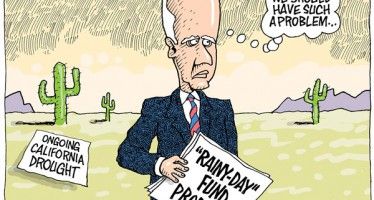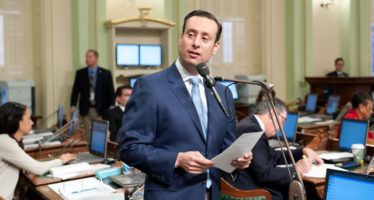Green Energy Reality Looming For CA
FEB. 15, 2011
By WAYNE LUSVARDI
After looking at televised images of at what is happening in Egypt last week, the Netherlands, in an abrupt turn around, announced on Feb. 11 that it is reducing its 20 percent target for renewable energy, cutting wind and solar power subsidies, and approving nuclear power plants, which have been banned for the past 40 years.
In the rest of Europe there is panic as the green energy bubble is collapsing due to rising oil prices as a result of Middle East turmoil, as well as the rush to develop cheap shale oil resources using new “fracking” technologies. Investors in green energy are suddenly facing the prospect of bankruptcy as European governments are announcing that they are ending “Feed-In-Tariffs” (subsidies) for green energy projects.
On Feb. 12 the Canadian Province of Ontario acted quickly and declared that it is abandoning plans for wind energy development because “there isn’t a lick of evidence they do any good.”
What will California’s green Governor Brown do now that green energy is collapsing everywhere else? Brown and a majority of California voters shot down Proposition 23 at the ballot box about three months ago, which would have suspended the roll out of green power until more favorable economic conditions appeared.
Last June, then-Attorney General Jerry Brown’s appeal to the Obama-controlled Federal Energy Regulatory Commission (FERC) for approval to load the high cost of green power onto the backs of electricity ratepayers was denied. FERC’s reasoning for rejecting Brown’s appeal was that California was trying to control both wholesale and retail ends of the energy market, which would have ended up in “gaming” the market, a la Enron.
Just recently, Gov. Brown stacked the Public Utilities Commission with euphemistic “consumerists” with long records in union activism and lobbying. Brown apparently is still positioning the CPUC for approving what are called “Feed-In Tariffs,” another term meant to disguise a subsidy for green power providers by hitting consumers with higher electricity rates. In California, “consumerism” is the new double talk term for unionism and jobs programs. Even Sacramento Bee columnist Dan Walters has recently come out calling green energy another form of “voodoo economics,” as well as “another form of consumerism, not a value added activity.”
Wind energy is poised for an eventual fall as the Section 1603 up-front cash payments of 30 percent for renewable power projects expires in 2012, and the Wind Production Tax Credit expires in 2013. Such subsidies are likely to face stiff scrutiny by a new Republican-controlled House of Representatives. Expiring subsidies, together with falling natural gas prices that petrify wind energy developers, may result in wind power hitting the proverbial brick wall sometime after California’s green power law rolls out in 2012. But green energy investment markets are surely going to react way before that. What happens if private capital for green energy dries up in California, given the risks?
The impending collapse of green power may have an impact on CalPERS investments as well. CalPERS’ external fund manager Tom Styer “invested” $5 million to defeat Prop 23. Steyer’s Farallon Investments is heavily invested for CalPERS in conventional “dirty” energy stocks (coal, oil, natural gas, nukes) that stand to make a “killing” in the stock market if competition from cheap coal and hydropower can be embargoed using California’s green power law. Unless green power is fully hedged against loss, the collapse of green energy would throw a monkey wrench into any plan to gain windfall profits from green power projects.
CalPERS’ retirement fund grew by 13.3 percent in 2009 and 12.5 percent in 2010 compared to about a 3.5 percent return for a ten-year T-Bill today. In other words, CalPERS is investing in enterprises that are about 3.5 times more risky than a Treasury security.
CalPERS is apparently doing what Orange County did when it went bankrupt in 1994. It is rolling the dice with green energy bubble investments in the hopes of bailing out the huge deficit in the CalPERS pension system. Given the last two years performance, you might say that Tom Steyer and CalPERS are geniuses, and should replace Jerry Brown as governor.
But the problem with “bubble money” is that it is “easy come, easy go.” Like tulip bulb prices, investments in high-risk green power and manipulation of energy markets to reap unjust profits in conventional energy stocks, are prone to sudden collapse. And the market in green power is collapsing worldwide, possibly leaving California as the last holdout.
If green power collapses, California may be facing another energy crisis of how to pay off defunct green power projects in order to clean the air just as it did in 2001. Only in 2001, it was the unpaid bonds on old polluting power plants that had to be mothballed to clean the air that led to the California energy crisis. This time if green power collapses, the high stakes gamble to replenish the CalPERS pension fund may also fail.
In 2003, the unpaid bonds on mothballed polluting power plants had to be rolled into a $42 billion mega bond to be paid off by long-term contracts for electricity. Will this scenario repeat itself with increased electricity prices being forced on ratepayers to pay for defunct green power investments?
Gov. Brown and the California electorate sent a signal via the ballot box in November that the state was going to forge ahead with green power, no matter what. There has been such a large investment in green power in California, with the establishment of renewable energy programs in universities and every level of government, that it is unlikely that California will do what Holland, Great Britain, most of Europe, and Canada are doing. Environmentalists have waited for decades for the 2012 rollout of green power and they probably aren’t going to back out now.
Neither is it likely that Jerry Brown will defy the voters and his green voting block.
Where will it all end? Will Republicans who now control the U.S. House of Representatives find a way to end California’s green power mania? If so, they will be blamed for the collapse of California’s self-inflated green power bubble.
But what will Gov. Jerry Brown do? Will he pull the plug on green power as other nations are quickly doing, or will he override the circuit breakers perhaps resulting in a green energy market crash that may affect utility ratepayers and the CalPERS pension fund?
If the 2001 Energy Crisis is a prototype of how California may manage any green power collapse now or in the future, an artificial energy crisis will be created to serve as a cover for raising electricity rates to pay for bad green power investments.
Brown likes to fashion himself as a modern day example of the wise Greek ruler Aristide “The Just.” Perhaps a more appropriate figure would be the mythical Greek figure Procrustes, who put people on an iron bed and either stretched them or amputated them to fit the size of the bed. As the myth goes, later Theseus captured Procrustes and fitted him to his own bed.
Recently, Jerry Brown put the redevelopment and affordable housing bubbles on his Proctrustean bed and amputated them. But Brown has built himself a green energy bed, and he may now have to lay on it while the green power bubble is also punctured and deflated. It would be a stunning defeat early in his term of office.
And the “dirty oil” companies that backed Prop 23 last November’s may end up as having been wiser than the green guru and self-styled Greek philosopher-king Jerry Brown.
Related Articles
Brown orders new emissions cuts
At a high-powered leadership gathering in Los Angeles, Gov. Jerry Brown detailed plans, laid out in a new executive order,
Brown submits May Revise budget
Yesterday, Gov. Jerry Brown submitted the May Revision of his 2014-15 budget proposal with a mixture of line-item revisions. Most were
Lawmaker accused of domestic violence to stay in Assembly leadership
Assemblyman Roger Hernández, who last week was placed under a temporary restraining order from his wife, will not be stripped of his




